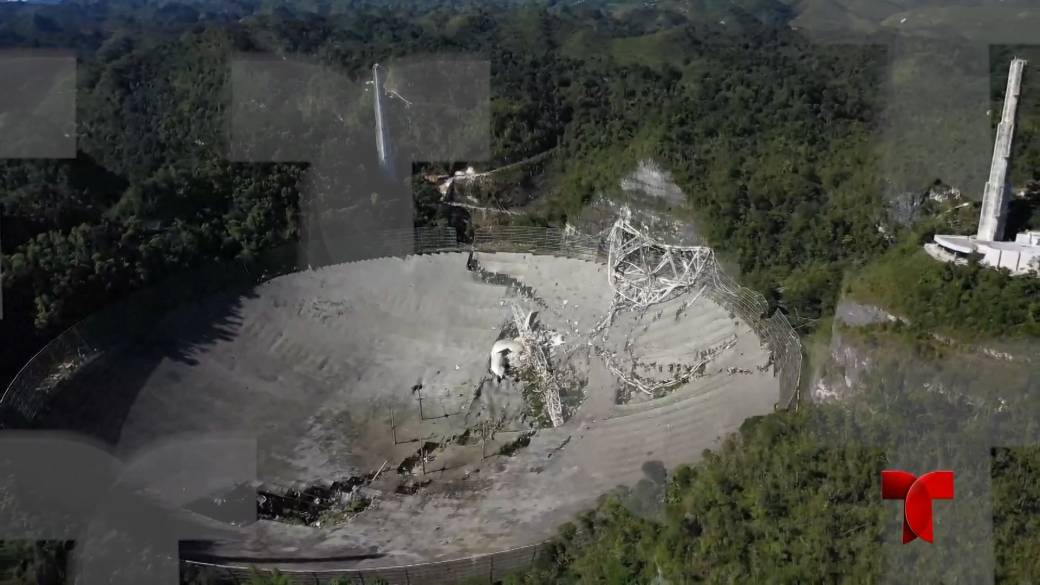Science
Footage shows catastrophic collapse of iconic Puerto Rico telescope – Global News

Dramatic video from Puerto Rico captures the moment when a 816-tonne platform came crashing down on the Arecibo Observatory, shattering one of the world’s largest telescopes and striking a crushing blow to the global scientific community.
The catastrophic collapse happened on Dec. 1, less than two weeks after the U.S. National Science Foundation (NSF) warned that such a disaster was imminent. The NSF had already shuttered operations at the facility after a suspension cable snapped and slashed a hole in the dish last month.
The telescope was the largest of its kind when it opened in 1963, and it has contributed to all manner of astronomical discoveries over the years, from asteroids to planets to mysterious radio signals in space. It also won a place in pop culture as the set for such films as Contact and GoldenEye, the first James Bond movie starring Pierce Brosnan.
The observatory’s telescope consisted of a 816-tonne reflector dish platform suspended 137 metres above a massive, bowl-like dish, which measured 305 metres across.
Suspension cables holding up the platform snapped on Dec. 1, dropping the heavy platform on the dish with a tremendous crash.
Video captured by the Arecibo control tower shows one of the three major cables snapping, causing the platform to swing down on the remaining cables before snapping them, too.
The footage shows the reflector dish platform falling apart in mid-air, while dragging down several support towers behind it.
Drone footage captured from one of the support towers shows the moment when the first cable snapped. The cable snapped at the tower, then the whole structure came crashing down, pulling other towers with it and cracking the bowl of the telescope. Large clouds of dust rose from the bowl after the catastrophe.
Jonathan Friedman, who worked for 26 years at the facility and still lives nearby, described the awful sound of the collapse in an interview with the Associated Press.
“It sounded like a rumble. I knew exactly what it was,” he said. “I was screaming. Personally, I was out of control. … I don’t have words to express it. It’s a very deep, terrible feeling.”
Many scientists, Puerto Rico residents and other public figures mourned the telescope’s loss after it was closed, and again after it collapsed.
Ángel Vázquez, the telescope’s director of operations, said it was no surprise when the telescope fell apart early Tuesday.
“It was a snowball effect,” he said. “There was no way to stop it. … It was too much for the old girl to take.”
© 2020 Global News, a division of Corus Entertainment Inc.
Science
SpaceX sends 23 Starlink satellites into low-Earth orbit


|
|
April 23 (UPI) — SpaceX launched 23 Starlink satellites into low-Earth orbit Tuesday evening from Space Launch Complex 40 at Cape Canaveral Space Force Station in Florida.
Liftoff occurred at 6:17 EDT with a SpaceX Falcon 9 rocket sending the payload of 23 Starlink satellites into orbit.
The Falcon 9 rocket’s first-stage booster landed on an autonomous drone ship in the Atlantic Ocean after separating from the rocket’s second stage and its payload.
The entire mission was scheduled to take about an hour and 5 minutes to complete from launch to satellite deployment.
The mission was the ninth flight for the first-stage booster that previously completed five Starlink satellite-deployment missions and three other missions.





Science
NASA Celebrates As 1977’s Voyager 1 Phones Home At Last


|
|
Voyager 1 has finally returned usable data to NASA from outside the solar system after five months offline.
Launched in 1977 and now in its 46th year, the probe has been suffering from communication issues since November 14. The same thing also happened in 2022. However, this week, NASA said that engineers were finally able to get usable data about the health and status of its onboard engineering systems.
Slow Work
Fixing Voyager 1 has been slow work. It’s currently over 15 billion miles (24 billion kilometers) from Earth, which means a radio message takes about 22.5 hours to reach it—and the same again to receive an answer.
The problem appears to have been its flight data subsystem, one of one of the spacecraft’s three onboard computers. Its job is to package the science and engineering data before it’s sent to Earth. Since the computer chip that stores its memory and some of its code is broken, engineers had to re-insert that code into a new location.
Next up for engineers at NASA’s Jet Propulsion Laboratory in California is to adjust other parts of the FDS software so Voyager 1 can return to sending science data.
Beyond The ‘Heliopause’
The longest-running and most distant spacecraft in history, Voyager 1, was launched on September 5, 1977, while its twin spacecraft, Voyager 2, was launched a little earlier on August 20, 1977. Voyager 2—now 12 billion miles away and traveling more slowly—continues to operate normally.
Both are now beyond what astronomers call the heliopause—a protective bubble of particles and magnetic fields created by the sun, which is thought to represent the sun’s farthest influence. Voyager 1 got to the heliopause in 2012 and Voyager 2 in 2018.
The Pale Blue Dot is a photograph of Earth taken Feb. 14, 1990, by NASA’s Voyager 1 at a distance of … [+]
NASA/JPL-Caltech
Pale Blue Dot
Since their launch from Cape Canaveral, Florida, aboard Titan-Centaur rockets, Voyager 1 and Voyager 2 have had glittering careers. Both photographed Jupiter and Saturn in 1979 and 1980 before going their separate ways. Voyager 1 could have visited Pluto, but that was sacrificed so scientists could get images of Saturn’s moon, Titan, a maneuver that made it impossible for it to reach any other body in the solar system. Meanwhile, Voyager 2 took slingshots around the planets to also image Uranus in 1986 and Neptune in 1989—the only spacecraft ever to image the two outer planets.
On February 14, 1990, when 3.7 billion miles from Earth, Voyager 1 turned its cameras back towards the sun and took an image that included our planet as “a mote of dust suspended in a sunbeam.” Known as the “Pale Blue Dot,” it’s one of the most famous photos ever taken. It was remastered in 2019.





Science
NASA hears from Voyager 1, the most distant spacecraft from Earth, after months of quiet
|
|
CAPE CANAVERAL, Fla. (AP) – NASA has finally heard back from Voyager 1 again in a way that makes sense.
The most distant spacecraft from Earth stopped sending back understandable data last November. Flight controllers traced the blank communication to a bad computer chip and rearranged the spacecraft’s coding to work around the trouble.
NASA’s Jet Propulsion Laboratory in Southern California declared success after receiving good engineering updates late last week. The team is still working to restore transmission of the science data.
It takes 22 1/2 hours to send a signal to Voyager 1, more than 15 billion miles (24 billion kilometers) away in interstellar space. The signal travel time is double that for a round trip.
Contact was never lost, rather it was like making a phone call where you can’t hear the person on the other end, a JPL spokeswoman said Tuesday.
Launched in 1977 to study Jupiter and Saturn, Voyager 1 has been exploring interstellar space – the space between star systems – since 2012. Its twin, Voyager 2, is 12.6 billion miles (20 billion kilometers) away and still working fine.





-



 Health17 hours ago
Health17 hours agoRemnants of bird flu virus found in pasteurized milk, FDA says
-
Art23 hours ago
Mayor's youth advisory council seeks submissions for art gala – SooToday
-



 Health21 hours ago
Health21 hours agoBird flu virus found in grocery milk as officials say supply still safe
-



 Investment21 hours ago
Investment21 hours agoTaxes should not wag the tail of the investment dog, but that’s what Trudeau wants
-
News13 hours ago
Amid concerns over ‘collateral damage’ Trudeau, Freeland defend capital gains tax change
-
Art17 hours ago
Random: We’re In Awe of Metaphor: ReFantazio’s Box Art
-
News22 hours ago
Peel police chief met Sri Lankan officer a court says ‘participated’ in torture – Global News
-
Art22 hours ago
An exhibition with a cause: Montreal's 'Art by the Water' celebrates 15 years – CityNews Montreal






